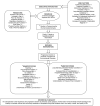Development of a Conceptual Framework for Severe Self-Neglect (SN) by Modifying the CREST Model for Self-Neglect
- PMID: 34079809
- PMCID: PMC8165169
- DOI: 10.3389/fmed.2021.654627
Development of a Conceptual Framework for Severe Self-Neglect (SN) by Modifying the CREST Model for Self-Neglect
Abstract
Self-neglect is an inability or refusal to meet one's own basic needs as accepted by societal norms and is the most common report received by state agencies charged with investigating abuse, neglect and exploitation of vulnerable adults. Self-neglect is often seen in addition to one or multiple conditions of frailty, mild to severe dementia, poor sleep and depression. While awareness of elder self-neglect as a public health condition and intervention has significantly risen in the past decade as evidenced by the increasing amount of literature available, research on self-neglect still lacks comprehensiveness and clarity since its inception to the medical literature in the late 1960s. With the burgeoning of the older adult population, commonness of self-neglect will most likely increase as the current incidence rate represents only the "tip of the iceberg" theory given that most cases are unreported. The COVID-19 pandemic has exacerbated the incidence of self-neglect in aged populations and the need for the use of intervention tools for aging adults and geriatric patients living alone, many of which may include in-home artificial intelligence systems. Despite this, little research has been conducted on aspects of self-neglect other than definition and identification. Substantial further study of this disorder's etiology, educating society on early detection, and conceivably preventing this syndrome altogether or at least halting progression and abating its severity is needed. The purpose of this research is to provide a definition of severe self-neglect, identify key concepts related to self-neglect, comprehensively describe this syndrome, present a conceptual framework and analyze the model for its usefulness, generalizability, parsimony, and testability.
Keywords: artificial intelligence; cognition; geriatrics; self-neglect; sleep.
Copyright © 2021 Pickens, Daniel, Jones and Jefferson.
Conflict of interest statement
The authors declare that the research was conducted in the absence of any commercial or financial relationships that could be construed as a potential conflict of interest.
Figures
Similar articles
-
Prevalence of elder self-neglect in a Chicago Chinese population: The role of cognitive physical and mental health.Geriatr Gerontol Int. 2016 Sep;16(9):1051-62. doi: 10.1111/ggi.12598. Epub 2015 Sep 3. Geriatr Gerontol Int. 2016. PMID: 26337031
-
Sociodemographic and socioeconomic characteristics of elder self-neglect in an US Chinese aging population.Arch Gerontol Geriatr. 2016 May-Jun;64:82-9. doi: 10.1016/j.archger.2016.01.007. Epub 2016 Jan 12. Arch Gerontol Geriatr. 2016. PMID: 26952381 Free PMC article.
-
High prevalence of medication non-adherence in a sample of community-dwelling older adults with adult protective services-validated self-neglect.Drugs Aging. 2012 Sep;29(9):741-9. doi: 10.1007/s40266-012-0007-2. Drugs Aging. 2012. PMID: 23018610
-
Self-neglect in older adults: an evolutionary concept analysis.Int J Nurs Stud Adv. 2025 May 9;8:100350. doi: 10.1016/j.ijnsa.2025.100350. eCollection 2025 Jun. Int J Nurs Stud Adv. 2025. PMID: 40491902 Free PMC article. Review.
-
Toward the realization of a better aged society: messages from gerontology and geriatrics.Geriatr Gerontol Int. 2012 Jan;12(1):16-22. doi: 10.1111/j.1447-0594.2011.00776.x. Geriatr Gerontol Int. 2012. PMID: 22188494 Review.
Cited by
-
Mindfulness and self-regulation intervention for improved self-neglect and self-regulation in diabetic older adults.Sci Rep. 2024 Jun 15;14(1):13857. doi: 10.1038/s41598-024-64314-y. Sci Rep. 2024. PMID: 38879620 Free PMC article. Clinical Trial.
-
Prevalence and correlates of elder neglect in the community-dwelling Chinese population: New evidence from the CLHLS study.Front Public Health. 2023 Mar 13;11:1123835. doi: 10.3389/fpubh.2023.1123835. eCollection 2023. Front Public Health. 2023. PMID: 36992875 Free PMC article.
-
Prevalence of self-neglect and related factors among older adults living in Western Turkey: a cross-sectional study.BMC Geriatr. 2024 Dec 24;24(1):1036. doi: 10.1186/s12877-024-05558-1. BMC Geriatr. 2024. PMID: 39716082 Free PMC article.
-
The relationships between self-neglect and depression, social networks, and health literacy in Turkish older adults: a cross-sectional study.BMC Public Health. 2025 Apr 10;25(1):1346. doi: 10.1186/s12889-025-22609-3. BMC Public Health. 2025. PMID: 40211190 Free PMC article.
-
Meeting the challenges in conducting research in vulnerable older adults with self-neglect-notes from a field team.Front Med (Lausanne). 2023 Mar 29;10:1114895. doi: 10.3389/fmed.2023.1114895. eCollection 2023. Front Med (Lausanne). 2023. PMID: 37064031 Free PMC article.
References
-
- Administration on Aging . >The 2004 Survey of State Adult Protective Services: Abuse of Adults 60 Years of Age and Older. (2006). Available online at: https://vtdigger.org/wp-content/uploads/2011/08/20110807_surveyStateAPS.pdf (accessed September 5, 2007).
Grants and funding
LinkOut - more resources
Full Text Sources
Miscellaneous


